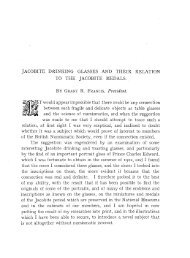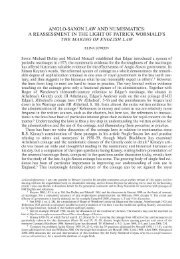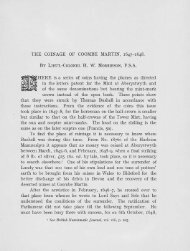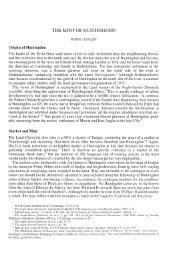MONEYERS IN THE 1130 PIPE ROLL
MONEYERS IN THE 1130 PIPE ROLL
MONEYERS IN THE 1130 PIPE ROLL
You also want an ePaper? Increase the reach of your titles
YUMPU automatically turns print PDFs into web optimized ePapers that Google loves.
<strong>MONEYERS</strong> <strong>IN</strong> <strong>THE</strong> <strong>1130</strong> <strong>PIPE</strong> <strong>ROLL</strong><br />
SIR IAN STEWART<br />
S<strong>IN</strong>CE the coinage of Henry I, for long largely neglected, has recently been the subject of<br />
renewed debate, it may be useful to collect together the relevant information from the one<br />
surviving Pipe Roll from the reign. Although Andrew noted many of the entries in his<br />
'Numismatic History' ninety years ago, they are scattered through his text and not<br />
considered collectively. 1 In consequence, they do not seem to have received the attention<br />
they deserve. The Pipe Roll is the earliest extant document of its kind in the English<br />
records, indeed the only one from the Norman period, and contains accounts of the king's<br />
revenue for the twelve months from Michaelmas 1129 to Michaelmas <strong>1130</strong>. 2 For the<br />
numismatist it could hardly come at a more interesting time, since major monetary changes<br />
took place in the later years of Henry I and there has been a wide divergence of views<br />
about the chronology of the fifteen coin-types of the reign. 3<br />
Several chronicles record an assize held in Winchester, at Christmas 1124 according to<br />
the Anglo-Saxon Chronicle, to investigate the conduct of moneyers from mints throughout<br />
the kingdom. 4 As a result of this, many of them are reported to have suffered punishment<br />
by mutilation for abuses of the coinage, although the numbers involved vary in different<br />
sources. From the names of mints and moneyers on the surviving coins it appears that more<br />
than half of the fifty-one mints known to have produced type XIV were not operating<br />
during the issue of type XV. 5 These were mainly the lesser mints, of which only one or two<br />
moneyers are recorded in type XIV, but there was also an unparalleled degree of<br />
discontinuity in the names of moneyers at those mints that remained active in type XV. It is<br />
natural to see the wholesale replacement of moneyers, although not necessarily the closure<br />
of the lesser mints, as a consequence of the Winchester assize, and it has accordingly been<br />
suggested that the introduction of type XV should be dated shortly after this, with type<br />
XIV as the issue current up to the time of the assize. Type XV was undoubtedly a longer<br />
type than all or most of the other issues of the reign, but whether it can be allocated a span<br />
of more than ten years, from early 1125 to the end of 1136, is a question that requires<br />
further consideration. Although the Pipe Roll entries do not themselves answer it, they do<br />
supply some interesting evidence about a number of moneyers of the period.<br />
Despite the intensive work done on the late Saxon and Norman coinage in recent years,<br />
we still do not know the mechanism by which the periodic renovatio monetae, the central<br />
feature of English coinage from Edgar's reform in the 970s to the end of the Norman<br />
period, was implemented. 6 Dolley assumed that within a limited period from the<br />
1 W.J. Andrew, 'A numismatic history of the reign of<br />
Henry I, 1100-1135' NC 4th ser., 1 (1901).<br />
2 Pipe Roll 31 Henry I, edited by J. Hunter (1833); for a<br />
recent discussion of its contents see J.A. Green, The<br />
Government of England under Henry I (Cambridge, 1986),<br />
especially chapter 4.<br />
3 For a valuable survey of evidence and opinions, see M.<br />
Blackburn, 'Coinage and Currency under Henry I: a<br />
Review', Anglo-Norman Studies XIII (1990), 49-81, which<br />
includes comprehensive references to the relevant literature.<br />
4 For documentary references to the Winchester assize,<br />
see G.C. Brooke, BMC Norman Kings (1916), I, cxliv-v.<br />
Symeon of Durham, who died c. 1129, puts the assize two<br />
years later. Green (see n.2), pp. 18 and 89-90, suggests that<br />
'what finally goaded Henry to take action were the<br />
complaints of his mercenary knights in Normandy about the<br />
poor quality of the coins in which their wages were paid',<br />
citing Robert of Torigny's interpolations in William of<br />
Jumieges, Gesta Normannorum Ducum, p. 297.<br />
5<br />
I. Stewart, 'Type XV of Henry I', SCMB Nov. 1989,<br />
259-64.<br />
6<br />
For recent discussions of the renovatio system see I.<br />
Stewart, 'Coinage and recoinage after Edgar's reform', in<br />
Studies in Anglo-Saxon Coinage, edited by K. Jonsson,<br />
Numismatiska Meddelanden 35 (Stockholm, 1990), pp. 455-85<br />
and M. Blackburn, 'Aethelred's coinage and the payment of<br />
tribute', in The Battle of Maldon, A.D. 991, edited by D.G.<br />
Scragg and M. Deegan (Manchester, 1991), pp. 156-69.
2 <strong>MONEYERS</strong> <strong>IN</strong> <strong>THE</strong> <strong>1130</strong> <strong>PIPE</strong> <strong>ROLL</strong><br />
introduction of a new type all citizens were required to take their old pennies to the nearest<br />
mint and exchange them for new ones. Others have suggested the recoinage was the<br />
practical consequence of a provision that certain official payments such as taxes should<br />
only be made in the current type of coin, or that sheriffs had to account to the exchequer<br />
for the returns from their counties in coin produced by their own moneyers. But, whatever<br />
the mechanism, the type XV system would have constituted a radical financial upheaval<br />
(although seemingly one put into reverse soon after Henry's death, when most of the<br />
smaller mints were revived). There would certainly have been consequences for royal<br />
revenue, perhaps in respect of taxation itself, but even if not, through loss of farms, fees or<br />
seignorage, for which the crown could be expected to have sought some compensating<br />
remedy. Whatever the reason had been during the previous hundred and fifty years for<br />
having a comprehensive network of mints, county by county, it can no longer have applied<br />
during the currency of type XV, or at least not in the same way. The reduction in the<br />
number of mints and moneyers after type XIV therefore goes far beyond the necessary<br />
process of replacing dishonest moneyers with new ones, but why such far-reaching changes<br />
were introduced remains unexplained. It is, however, against that background that we<br />
need to consider the occurrence of the names of moneyers in the Pipe Roll.<br />
Moneyers had figured in English official documents since the time of Offa, and there are<br />
many instances in the Saxon period to suggest that they were persons of rank and<br />
importance in public affairs. 7 When the exchequer and other records become plentiful,<br />
from the second half of the twelfth century, there are frequent references to men described<br />
as moneyers, and it is likely that others named include persons who at one time or another<br />
were responsible for coinage. Most of the names of moneyers in the Pipe Rolls of Henry II<br />
find mention there at approximately the dates when they were signing coins, but there are<br />
entries which imply that the moneyer concerned was not currently exercising the office,<br />
many of the entries repeated from year to year being of this kind. More than twenty of the<br />
names recorded under Henry II can be identified as moneyers of Stephen, mostly not<br />
continuing after 1158, and many of these entries must therefore fall some years after the<br />
persons concerned had ceased to be named on the coinage. 8 One should not be surprised to<br />
find the same thing happening under Henry I. Fines or other debts were often carried<br />
forward from year to year, as is evident from the repeated entries in the period where the<br />
rolls survive continuously. In the case of the <strong>1130</strong> Pipe Roll, because it stands alone, this<br />
unfortunately means that we do not know when such debts were first incurred, or how<br />
much of the original debt had by then been discharged.<br />
A further problem in relation to the reign of Henry I is that our record of mints and<br />
moneyers is so incomplete. Because of such large hoards as Bournemouth, Lincoln,<br />
'Beauvais' and Watford, from the later years of Henry I's reign or the beginning of<br />
Stephen's, we must know the great majority of mints and moneyers' names in types XIV<br />
and XV, but even in these two types the 'Beauvais' hoard contained surprises, adding the<br />
mints of Pembroke and Sudbury in type XV, the latter particularly unexpected as making<br />
Suffolk the only county in the kingdom to have had three mints active during the type. Of<br />
the first thirteen types of the reign it is clear that we know only a selection of the mints and<br />
moneyers, and new hoards can be relied upon to increase their number substantially. Thus<br />
the Lincoln hoard added no fewer than fifteen new moneyer/type combinations for the<br />
Lincoln mint from types VII to XV. Any discussion of the careers of individual moneyers<br />
can therefore only be of a most provisional kind, and is liable to major revision in the light<br />
of subsequent discoveries. The table appended hereunder of the types recorded for the<br />
7 I. Stewart, 'Ministri and Monetarii', RN 30 (1988), Elmore Jones, 'Stephen Type VII', BNJ 28 (1955-7), 537-54<br />
166-75. (see p. 547).<br />
8 D.F. Allen, BMC Henry II, pp. lxv-lxxi and cv-cvi; F.
<strong>MONEYERS</strong> <strong>IN</strong> <strong>THE</strong> <strong>1130</strong> <strong>PIPE</strong> <strong>ROLL</strong><br />
moneyers mentioned in this article should accordingly be treated with appropriate reserve.<br />
Although only four persons are actually described as moneyers in the <strong>1130</strong> Pipe Roll,<br />
several others can be confidently identified as moneyers because of the nature of the<br />
entries, and in a number of other cases there are coincidences of name and place that point<br />
to the possibility, indeed often the likelihood, of identity between men named on the<br />
coinage and in the Roll. For example, a moneyer Edric coined at Stafford, Bristol and<br />
Hereford in the later types of Henry and the first of Stephen, while an Edric is found<br />
standing surety in Staffordshire in <strong>1130</strong>. 9 In Essex an Edward accounted for 36s. 8d. (of<br />
which he paid £1), 10 and there was an Edward minting at Colchester in Henry's type XIII<br />
and Stephen's type I. The reeve {propositus) of Thetford, who owed £35 2s. 8d., was called<br />
Fulchard, 11 surely the same man as the Folcard who struck coins of Henry I type XIV in<br />
that borough. Another Thetford moneyer, in type XIV and earlier, was Godwine, perhaps<br />
the Godwin of Wichingeham who paid 40s. in Norfolk on the plea of Richard Bass 'de<br />
Tietford'. 12 In Nottinghamshire one Suein de Porta owed 100s., 13 and a Swein coined at<br />
Nottingham in the <strong>1130</strong>s. A moneyer called Wibert was in office at the same period at<br />
Gloucester, presumably the Wibert Savage who features in the Gloucestershire return. 14<br />
Odard, the vicecomes of Carlisle (also mentioned in the Roll in connection with his<br />
brother-in-law in Gloucestershire), 15 was the son of Hildret, one of the lessees of the<br />
Cumberland silver mines, and is perhaps to be identified with the Hudard whose name<br />
appears on some rare coins of Carlisle in Stephen's name. Even in the case of Driu, named<br />
under Carmarthen in the Pipe Roll, 16 there must be a chance of identity with the Hereford<br />
moneyer of the 1150s, despite the interval of time. But perhaps the most convincing case of<br />
all is that of Boneface, whose estate was the subject of an entry under Sussex 17 - such a<br />
rare name, occurring only this once in the Pipe Roll and only once on the Norman coinage,<br />
that it must refer to the moneyer who worked for Henry I at Hastings.<br />
The foregoing examples are sufficient to demonstrate the general tendency of persons<br />
who acted as moneyers to find mention in the exchequer accounts for one reason or<br />
another. Systematic study of the roll would no doubt reveal other cases. Thus, Mrs<br />
Nightingale is probably correct in identifying the Tovius, described as an engineer, who<br />
was excused from taxation, as the moneyer Tovi, who signed coins at Oxford and Stamford<br />
in type X and Twynham, Winchester and London from type XIV to Stephen type I. 18 This<br />
astonishing range of mints does indeed suggest that Tovi was no ordinary local moneyer,<br />
but held some unusual role in the king's administration. Also excused from taxation was<br />
Theoderic, son of Deorman, one of a long dynasty of moneyers, who is quite possibly to be<br />
equated with the Stephen moneyer who signs as Tierri D. 19<br />
The four persons described as moneyers in the roll were Brand (Honour of Arundel), 20<br />
Gillopatric (Pembroke), 21 Saiet (Hampshire) 22 and Ulchetell (Norfolk). 23 In the cases of<br />
four others the entries relate to minting offences - Algar, Spracheling and Godwin<br />
Quachehand, all at London, and Saiet's nephew Alvric under Hampshire. Most of these<br />
are immediately identifiable on the coinage. The name Spracheling is not found on coins of<br />
9 PR p. 75.<br />
10 PR p. 55.<br />
11 PR p. 98.<br />
12 PR p. 93.<br />
13 PR p. 9.<br />
14 PR p. 77; D.C. Douglas and G.W. Greenaway, English<br />
Historical Documents, II (1953), p. 611.<br />
15 PR pp. 79, 140 and 142; Andrew, p. 140. This<br />
identity would not be valid if Odard of Carlisle was the<br />
same as Odard of Bamburgh, who died between <strong>1130</strong> and<br />
1133 (Green, Government of England, pp. 156, n. 76, and<br />
264).<br />
16 PR p. 90.<br />
17 PR p. 69; Andrew, pp. 206 and 209.<br />
18 P. Nightingale, 'Some London moneyers, and reflections<br />
on the organization of English mints in the eleventh<br />
and twelfth centuries', NC 142 (1982), 34-50 (at p. 43); PR,<br />
p. 152.<br />
19 Nightingale, pp. 35ff; PR, p. 41.<br />
20 PR p. 42; Andrew, pp. 153 and 156-8.<br />
21 PR p. 136; Andrew, pp. 213 and 216-17.<br />
22 PR p. 40; Andrew, pp. 462-4.<br />
23 PR p. 94 (pecunia - probably 'chattels'); Andrew, pp.<br />
327 and 331-2.
4 <strong>MONEYERS</strong> <strong>IN</strong> <strong>THE</strong> <strong>1130</strong> <strong>PIPE</strong> <strong>ROLL</strong><br />
Henry I, but there was a Spracelinc at Winchester in the 1080s and 1090s and a Sperling or<br />
Sperlings at Hastings under William II and at London under William II and Henry I. Since<br />
Spracheling is bracketed in the roll with Algar, an undoubted London moneyer of Henry I,<br />
in respect of a coinage offence, there are good grounds for following Andrew in identifying<br />
him with the London moneyer Sperling. 24 Although it would imply a minting career of up to<br />
forty years, it is even conceivable that he was the same man not only as the Hastings Sperling,<br />
but also as the Winchester Spracelinc, since Winchester had frequently exchanged moneyers<br />
with the Sussex mints before the Conquest. 25 Sperling was a London alderman and Algar a<br />
canon of St Paul's. 26 Godwin Quachehand (is it too fanciful to interpret his byname as<br />
referring to the loss of his right hand by mutilation?) is probably to be identified as the<br />
GODP<strong>IN</strong>E GV on a unique coin, of illegible mint, of type XV, since G is sometimes used for Q<br />
on late Saxon coinage, and there was a Godwine at London in type XIV. 27<br />
Brand's entry provides what appears to be the only direct reference to the Winchester<br />
assize. He accounted for £20 'ne esset disfactus cum aliis monetariis'. He had paid £4 into<br />
the exchequer in 1129/30 and still owed £16. If he had been paying off his debt at the same<br />
annual rate since 1124/5, his original fine would have been £40. Brand was a prolific<br />
moneyer at Chichester up to type XIII, but he is known from only a single coin of type<br />
XIV. 28 Chichester, like all the other Sussex mints, was closed during type XV but there is a<br />
coin of Stephen type I of this mint with a short moneyer's name ending in D, 29 which seems<br />
to suggest that Brand briefly returned to office sometime after 1135. One wonders whether<br />
Brand can have been alone in being allowed to pay a fine by way of penalty instead of being<br />
mutilated with the other moneyers. Given the attractions of revenue to the crown, it could<br />
have been an option offered to quite a number of moneyers adjudged guilty provided that<br />
they could demonstrate the prospect of being able to pay. The Pipe Roll of 1124/5 would<br />
no doubt be an illuminating document on this score.<br />
Although not referring to the payment of fines in lieu of mutilation, many of the other<br />
entries relating to coinage offences are likely to date back to the Winchester assize. While<br />
that was very probably not the first or last occasion in the 1120s on which a moneyer was<br />
fined or otherwise punished, it was clearly much the most drastic and comprehensive, and<br />
presumably lies behind an entry such as that under Pembroke. There the moneyer<br />
Gillopatric accounted for £4 'pro foris(facto) veteris monete'. He had paid 40s. in 1129/30<br />
and still owed 40s. If paid at £2 per annum since 1124/5, his original fine would have been<br />
£14. Gillopatric's coins are known between type X of Henry and type I of Stephen, and are<br />
all very rare, as befits the output of a very small county mint where he was the only<br />
moneyer. The nature of his wrongdoing in relation to the old coinage is not stated, but if it<br />
was similar to Brand's the difference in the amount of their fines could have been due to<br />
the fact that the scale of Gillopatric's coinage was less.<br />
Algar and Spracheling, though not described as moneyers, are entered under London as<br />
owing 10 marks for an offence of false pennies ('pro foris(facto) falsorum denariorum'),<br />
which sounds like something close to forgery. Algar was a London moneyer in all types<br />
from X to XIV of Henry I, and several earlier. Although not known from official coins of<br />
type XV, he reappears in type I of Stephen. Andrew suggested that he may not have<br />
learned the lesson from his punishment, since there are some plated forgeries combining<br />
an obverse of Stephen with a reverse of Henry's type XV that appears to carry his name. 30<br />
24 PR p. 148; Andrew, pp. 275 and 282-4. Surprisingly,<br />
Brooke (BMC p. exlv) saw 'no reason to suppose' that Algar<br />
and Spracheling were moneyers. Dr Conte advises me that<br />
Sperling is now also known for Northampton in type X from<br />
a coin in the recent Mansfield-Woodhouse find.<br />
25 I. Stewart, 'The Sussex mints and their moneyers', in<br />
The South Saxons, edited by P. Brandon (1978), pp. 89-137.<br />
26 Nightingale, pp. 41, 43 and 48.<br />
27 PR p. 146; Andrew, pp. 282-3 and 300; again Brooke<br />
(BMC p. cxlv, n. 2) is sceptical.<br />
28 BMC 120.<br />
29 Glendining, 14 Oct. 1985, lot 50.<br />
30 Andrew, p. 283; SCBI Mack, no. 1582.
<strong>MONEYERS</strong> <strong>IN</strong> <strong>THE</strong> <strong>1130</strong> <strong>PIPE</strong> <strong>ROLL</strong><br />
Spracheling, if correctly identified with Sperling, does not feature on the coins after type<br />
XIII. Their fine, or at least the amount outstanding in <strong>1130</strong>, was not unduly large. Also<br />
expressed in marks, but of gold worth ten or twelve times as much as silver, was the debt of<br />
Godwin Quachehand who owed four marks of gold in order that he might have pardon for<br />
a placitum of the coinage (monete).<br />
Saiet's debt was of a different order. He owed the huge sum of 278 marks (£185 6s. 8d.)<br />
for the fee or payment {placitum) of two dies, while his nephew Alvric accounted for 24<br />
marks (£16) for 'falso cypho', of which he paid £4 and still owed 18 marks or £12. Whatever<br />
cypho means here, 31 Alvric had clearly been found to be dishonest. His coins are of the last<br />
two types of Henry I only, whereas Saiet's career started earlier and continued under<br />
Stephen. Mr Seaby has drawn attention to the fact that only three of the Winchester<br />
moneyers of type XIV, Alfric (= Alvric), Godwine and Saiet, continued into type XV, and<br />
he sees this as corroborating the statement in the Winton Annals that all the moneyers,<br />
except three of Winchester, were mutilated. 32 Since Saiet's debt is not stated to have been<br />
the penalty for an offence, it may have arisen for some other reason. There is no<br />
comparable entry in the roll, but as the equivalent of more than 44,000 silver pennies it is<br />
worth considering whether this could have represented the product of the two dies<br />
mentioned. As a punishment it would have been of exceptional severity for any offence, 33<br />
and if consequent upon the Winchester assize it would be odd that Saiet escaped<br />
mutilation. If, on the other hand, it represents some form of account, it could perhaps<br />
relate to silver provided by the crown for minting, since the Treasury was still held at<br />
Winchester at this date.<br />
In the cases of two of the moneyers mentioned in the <strong>1130</strong> Pipe Roll, the entries relate to<br />
their estates. Under Norfolk it is recorded that Edstan owed 100s. 'de pecunia' of Ulchetell<br />
the moneyer (Ulfcil on the coins). Edstan himself was also a Norwich moneyer, through<br />
most of the reign of Henry I and into Stephen's. The Ulchetell entry does, incidentally,<br />
demonstrate the impossibility of the chronology proposed by Dolley, which allowed an<br />
unrealistically brief period of issue for type XV, 1134—5, and put the start of type XIV in<br />
1131. 34 In this respect it is reinforced by the (defective) entry under Sussex recording that<br />
someone paid or owed money for title to the land of Boneface his relative, whose known<br />
coins of Hastings are of types X and XIV. Presumably Ulchetell and Boneface had died<br />
quite recently, although not necessarily in the year 1129/30 itself. The latest coins of each<br />
of them are of type XIV. In the case of Boneface this is not relevant to the date of the start<br />
of type XV, since the Sussex mints were all closed during that type. Norwich, however,<br />
took on an expanded role in type XV, and, unless suspended, Ulchetell might be expected<br />
to have contributed to it if it had been introduced before his death. This could suggest<br />
either that type XV began not long before 1129/30 or that the debt for his estate was<br />
outstanding for several years. Since Edstan and Ulchetell had been colleagues for a<br />
considerable period, and Edstan remained actively in office, the sheriff would presumably<br />
have endeavoured to collect the debt from him without undue delay.<br />
The roll does not name the moneyer Aedgar, but he deserves mention in a review of<br />
documentary references to moneyers in the later years of Henry I by virtue of his<br />
appointment as the abbot of Reading's moneyer. The foundation charter of the abbey,<br />
which (assuming it is authentic) is dated to 1125, had included in the privileges granted a<br />
31 If cyphus, normally meaning a cup, could here be used<br />
for cupella, the small cup in which silver was melted for<br />
assay, falso cypho could mean 'for false assay' or possibly<br />
'for false (coin exposed by) assay'.<br />
32 P. Seaby, 'Henry I coin types: design characteristics and<br />
chronology'; The Yorkshire Numismatist, I (1988), 27-43.<br />
33 However, some very heavy fines were sometimes<br />
imposed during the reign of Henry II: P.W.P. Carlyon-<br />
Britton, 'Historical notes on the first coinage of Henry II',<br />
BNJ II (1905), 185-242 (note especially the huge sums owed<br />
by Canterbury moneyers, pp. 188 and 220).<br />
34 M. Dolley, The Norman Conquest and the English<br />
Coinage (1966).
6 <strong>MONEYERS</strong> <strong>IN</strong> <strong>THE</strong> <strong>1130</strong> <strong>PIPE</strong> <strong>ROLL</strong><br />
mint and one moneyer at Reading. But by a writ of Roger of Salisbury, acting as viceroy in<br />
the king's absence, addressed to Alberic (Aubrey) de Vere as sheriff of London, this was<br />
varied to the grant of a moneyer at London, the first holder of the office to be Edgar. The<br />
date of the writ has been put between 1125 and 1128 or 1129. Aubrey seems to have ceased<br />
to be sheriff by Michaelmas 1128, but Henry was abroad from July 1123 to September 1126<br />
and August 1127 to July 1129 so it cannot belong to the period Sept. 1126 - Aug. 1127. 35<br />
Coins of London with the name Aedgar are known only of type XV, but he minted at<br />
Ipswich in types XIII and XIV and again under Stephen. If the date of the writ could be<br />
established more closely, therefore, it might offer a useful clue to when Edgar ceased to<br />
coin at Ipswich and took up office at London (although there may have been an interval<br />
between the two).<br />
None of the foregoing is at all conclusive as to the date when type XV, with its attendant<br />
reform of the mint network, was introduced, but it does throw some light on the process.<br />
Strangely, none of the persons described in the <strong>1130</strong> Pipe Roll as moneyers or as owing<br />
fines related to monetary offences appears, on the evidence of surviving coins, to have<br />
gone out of office permanently at the end, or during the course, of type XIV. The only<br />
moneyer of this kind who is unknown on coins later than type XIV is Spracheling, if the<br />
same as Sperling, but his coins end with type XIII. If we can take the individual Pipe Roll<br />
entries as representative, some of those punished did not operate in type XV although<br />
their mints remained active, e.g. Algar of London, but in the case of others, e.g. Brand of<br />
Chichester, their mints were closed anyway, so they were not necessarily debarred from<br />
office. Some were punished but continued in office in type XV, e.g. Gillopatric at<br />
Pembroke and Alvric at Winchester. In the light of this, I find it difficult to see the<br />
reduction in the number, and change in the identity, of moneyers between types XIV and<br />
XV as solely a response to the dishonest practices punished at the Winchester assize. For<br />
instance, Aedgar of Ipswich would presumably not have been given such a respectable post<br />
soon afterwards if he had been suspended from office at Ipswich for misbehaviour. Three<br />
of the five Ipswich moneyers of type XIV reappear under Stephen, including Aedgar, yet it<br />
was the Sudbury moneyer Osbern who was drafted to Ipswich as sole moneyer in type XV,<br />
while he in turn was replaced at Sudbury by one Godimer, not previously recorded on the<br />
coinage. It is not obvious why such a complex reshuffle should have been due to the<br />
Winchester purge. Mr Blackburn has drawn attention to the administrative reforms,<br />
concentrated in the years 1128-31, relating to the functions of the sheriffs in connection<br />
with the royal revenue, 36 and one wonders whether the role of the moneyer may have<br />
changed in type XV sufficiently to need a different type of person in many cases. The<br />
ending of coinage in several counties and the concentration of minting in (mostly) larger<br />
centres imply a fundamental change in the way that the recoinage system was operated and<br />
the king's revenue collected; and when the pre-XV system was, apparently, restored after<br />
1135, quite a number of the pre-XV moneyers reappeared with it. My impression - and I<br />
emphasize that it is no more than that - is that the type XV reform, although no doubt<br />
stimulated in part by the circumstances that led to the Winchester assize, was not a simple<br />
consequence of it, and went substantially beyond what was necessary to achieve the<br />
punishment or replacement of dishonest moneyers. More work is needed on this<br />
remarkable monetary reform, but any assessment of what it involved must take account of<br />
the moneyer entries in the <strong>1130</strong> Pipe Roll.<br />
35 Andrew, pp. 372-6. For the dating see B.R. Kemp,<br />
Reading Abbey Cartularies I (Camden 4th series, 31, 1986),<br />
no. 177, pp. 145-6 (1125x9) and E.J. Kealey, Roger of<br />
Salisbury, Viceroy of England (Berkeley, 1972), pp. 243-4<br />
(c. 1125-8); cf. C.N.L. Brooke and G. Keir, London<br />
800-1216: The Shaping of a City (1975), pp. 206 and 372, and<br />
J.A. Green, English Sheriffs to 1154 (PRO Handbook no.<br />
24, 1990), p. 58. I am indebted to Prof. Brooke for these<br />
references.<br />
36 Blackburn, 'Review', p. 75 citing Green, pp. 215-16.
<strong>MONEYERS</strong> <strong>IN</strong> <strong>THE</strong> <strong>1130</strong> <strong>PIPE</strong> <strong>ROLL</strong><br />
Finally, two general observations about personal names are perhaps worth making.<br />
First, the ratio of Norman names, Radulfs, Ricards, Rodberts, Walters and Willelms, to<br />
English names is much higher in the roll than on the coinage of Henry I, even than in the<br />
last two types of the reign, when moneyers with Norman names begin to be found at many<br />
mints. Men with pre-Conquest names seem therefore to have held their ground in the role<br />
of moneyers more effectively than in the central financial administration of the land. But it<br />
is noteworthy that the major replacement of moneyers between types XIV and XV was the<br />
first occasion when Norman names occur in reasonable abundance on the coinage. The<br />
second point is the persistence of some particular names in certain places or areas.<br />
Glancing at the text of the roll, I have, for instance, noticed a Leovric Locc under<br />
Hampshire, 37 and an Outi at Lincoln. 38 There had been a moneyer called Aestan Loc at<br />
Winchester in the late Saxon period, and one called Auti or Outi at Lincoln for Edward the<br />
Confessor. 39<br />
Moneyer<br />
Aedgar<br />
Alfric<br />
Algar<br />
Boniface<br />
Brand<br />
Driu<br />
Edric<br />
Edstan<br />
Edward<br />
Folcard<br />
Gillepatric<br />
Godwine<br />
GV<br />
37 PR p. 40.<br />
38 PR p. 111.<br />
Mint<br />
Ipswich<br />
London<br />
Winchester<br />
London<br />
Southwark<br />
Hastings<br />
Chichester<br />
Hereford<br />
Stafford<br />
Bristol<br />
Hereford<br />
Norwich<br />
Colchester<br />
Sudbury<br />
Thetford<br />
Pembroke<br />
London<br />
Pre-XIII<br />
III<br />
I-V, VII,<br />
X-XII<br />
VII, X, XI<br />
X<br />
VI, VII, X,<br />
XII<br />
X<br />
X, XII<br />
III-V, VII,<br />
X-XII<br />
Henry I<br />
XIII XIV<br />
x x<br />
X<br />
X X<br />
X X<br />
X<br />
X X<br />
XV<br />
X<br />
X<br />
Stephen<br />
I Later<br />
x II<br />
Mr Mark Blackburn, Prof. Christopher Brooke, Dr William<br />
Conte, Dr ludith Green, and Prof. Philip Grierson, with<br />
39 I am grateful for comments to Miss Marion Archibald, whom I have discussed the subject of this article.
Moneyer<br />
Godwine<br />
Hudard<br />
Saiet<br />
Sperlinc<br />
Swein<br />
Tierri D.<br />
Tovi<br />
Ulfcil<br />
Wibert<br />
Mint<br />
Norwich<br />
Thetford<br />
Carlisle<br />
Winchester<br />
Hastings<br />
London<br />
Nottingham<br />
London<br />
Oxford, Stamford<br />
Twynham<br />
Winchester<br />
London<br />
Norwich<br />
Gloucester<br />
<strong>MONEYERS</strong> <strong>IN</strong> <strong>THE</strong> <strong>1130</strong> <strong>PIPE</strong> <strong>ROLL</strong><br />
Pre-XIII<br />
V, X<br />
VII, IX, XI<br />
I, IV, VII, X<br />
I, VII, x, XI<br />
X<br />
X<br />
Henry I<br />
XIII XIV<br />
X<br />
X<br />
XV<br />
Stephen<br />
I Later<br />
x<br />
(x)<br />
x VII<br />
x VII<br />
II, VII



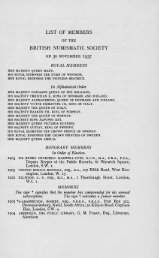

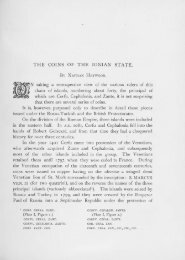
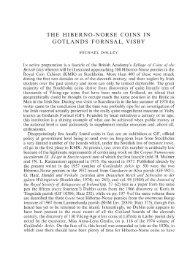
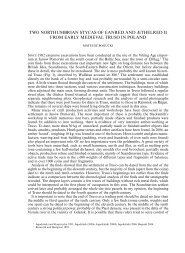

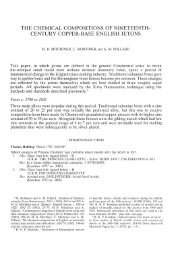
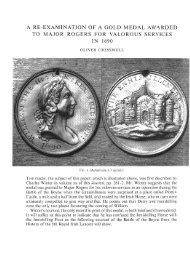
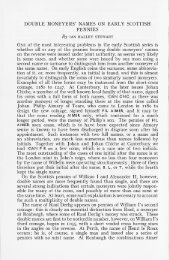
![Two Anglo-Saxon notes: [1] A Cnut die-link between the mints of ...](https://img.yumpu.com/15433998/1/189x260/two-anglo-saxon-notes-1-a-cnut-die-link-between-the-mints-of-.jpg?quality=85)
